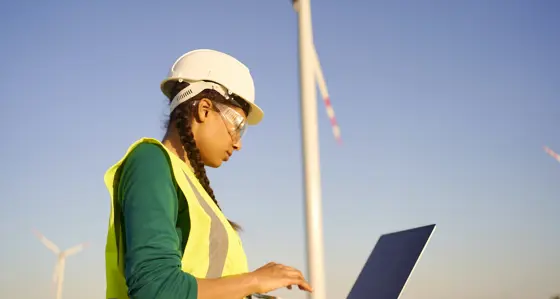
Renewables in the Nordics: 5 major trends
30 August 2022
The Nordic countries are world leaders in renewable energy with a high level of penetration of low carbon technologies in the power sector already. However, the region faces both short term and long-term challenges as it continues on the decarbonisation journey.
The European power industry went through a roller-coast ride in the last couple of years. The global pandemic and the resulting recession pushed power prices to record low levels in 2020. The strong economic rebound in 2021 created significantly inflationary pressure on supply chain and commodity prices that led to price surge in the wholesale market. Lately power prices have reached new highs amidst the backdrop of the Ukraine crisis and elevated risks around security of supply in Europe.
Despite a high penetration of renewables and relatively low dependence on fossil fuels in the power sector, the Nordics has not been immune to the recent commodity and power market volatility. Variation of hydro conditions and intermittency of wind resources, both featuring prominently in the supply mix, created additional risks that renewable asset owners had to navigate.
In a recent webinar hosted by Baringa as part of its Low Carbon Futures series, a panel of energy industry experts discussed the opportunities and challenges facing the Nordics renewable energy industry during a period of uncertainty in global energy markets.
Panellists:
Jorn Leeuwendal, Deputy Head of Origination Energy, NORD/LB
Tomas Gärdfors, Partner, Head of Nordic, Norton Rose Fulbright
Yinfan Zhang, Expert in Low Carbon Solutions, Baringa
Chair: Ilesh Patel, Partner, Energy and Resources, Baringa
5 major trends for Nordics renewables emerged through the course of the conversation:
Change in balance between PPA and merchant
Asset owners are re-assessing the appropriate level of hedging through PPAs from a risk management and profit optimisation perspective. Baseload PPAs are the predominant form of offtake in the Nordics in recent years. A high level of coverage (e.g. > 70%) provides revenue certainty and enables project finance. However it limits the overall return and potential upside, while also exposing the project to volume and shape risks. Asset owners are asking whether contracted baseloads should be scaled back, and how to strike a more profitable balance between baseload PPA and merchant revenues.
Project finance still requires revenue certainty
There is an increasing number of projects in the Nordics that operate on a purely merchant basis without PPA. These projects are usually funded by equity or alternatives to tradition loans such as infrastructure debt, mezzanine loan and preferred equity. Project finance providers are still looking for revenue certainty and limit on exposure to merchant risks.
The market, however, is innovating and looking for ways to set up deals so that lenders can still have downside risk protection, while allowing producers to benefit when merchant pricing is higher than rates agreed in PPAs.
Rising demand v supply side constraints
Demand in the region is projected to rise significantly over the coming years, driven by growing industrial consumption, further roll out of electric vehicles (EVs) and further electrification (e.g. adoption of large scale heat pumps) of the heating sector. Metals and mining, refining, manufacturing and data centres are the key sectors driving industrial demand growth. Most of the these will have “green” and “additionality” requirements.
Over the last five years the Nordics has seen around 3 GW per year of renewable growth. To meet the additional demand in the next decade, renewables would need to be deployed twice as fast, if not more. This can be challenging against the backdrop of permitting difficulties in certain price zones, supply chain disruptions and grid constraints. These obstacles need to be overcome for the decarbonisation ambitions to be realised by the Nordic countries.
There has, however, been some progress in these areas. For example, transmission operators in Sweden and Norway are putting forward proposals to improve transmission capacity in constrained areas. The Swedish government is also working on shortening the permit process.
Higher financing costs
Rising inflation and interest rate hikes have pushed up financing costs. High power prices, however, have had a positive impact on the cash flows of producers with non-contracted revenues in their revenue stacks, offsetting the impact of higher financing costs.
Increasing cannibalisation risk
Cannibalisation risk for onshore wind has been increasing across the region. In the short term, wholesale price volatility (which wind farms are not well placed to capture) and transmission constraints could further contribute to this risk. Over the long term the growth in wind capacity is a structural driver of cannibalisation risk. Offtakers are increasingly pushing the risk to asset owners, through baseload PPAs (where the asset owners take the intermittency risk), significant capture discount applied on the forward curve and other means.
Related Insights

What might a reformed GB national power market look like under REMA?
Discover how a reformed national market is likely to include significant changes to current market arrangements, with material impacts for market participants.
Read more
Investing in uncertainty: European power market outlook 2025
Our latest outlook points to a more uncertain energy transition, shaped by political and economic volatility across Europe in the form of Trade Wars, Populism and Remilitarisation.
Read more
REMA and investing in GB power market under uncertainty
Learn about the opportunities and challenges of investing in the GB power market under uncertainty and how Baringa can help
Read more
Three ways in which increased volatility and flexibility are reshaping Spain’s energy market
Spain's energy market faces profound change due to curtailment, negative prices, and a recent blackout, discussed at our roundtable event.
Read moreIs digital and AI delivering what your business needs?
Digital and AI can solve your toughest challenges and elevate your business performance. But success isn’t always straightforward. Where can you unlock opportunity? And what does it take to set the foundation for lasting success?